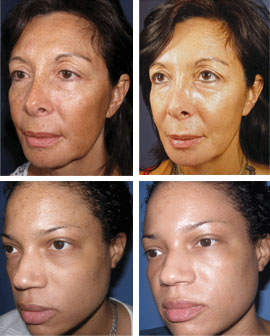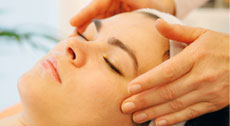
What you can expect
A chemical peel is typically done in an office-based procedure room or outpatient surgical facility. Before the procedure, your doctor will clean your face and might cover your eyes with ointment, gauze, tape or goggles. He or she might also protect your hair.
Pain relief isn’t typically needed for a light chemical peel. If you’re having a medium chemical peel, you might have the option of taking a sedative and a painkiller.
If you’re having a deep chemical peel, your doctor will likely numb your skin with a local anesthetic and give you a sedative or use regional anesthesia — which numbs a certain part of your body.
During the procedure
During a light chemical peel:
- Your doctor will use a brush, cotton ball, gauze or sponge to apply a chemical solution typically containing glycolic acid or salicylic acid. The treated skin will begin to whiten.
- You might feel mild stinging while the chemical solution is on your skin.
- Your doctor will apply a neutralizing solution or wash to remove the chemical solution from the treated skin.
During a medium chemical peel:
- Your doctor will use a cotton-tipped applicator or gauze to apply a chemical solution containing trichloroacetic acid, sometimes in combination with glycolic acid. The treated skin will begin to whiten.
- After a few minutes, your doctor will apply cool compresses to soothe treated skin. You might also be given a hand-held fan to cool your skin. No neutralizing solution is needed, however.
- You might feel stinging and burning for up to 20 minutes.
After the procedure
After a chemical peel of any depth, follow your doctor’s directions for cleansing, moisturizing and applying protective ointments to your skin.
After a light chemical peel, treated skin will be red, dry and mildly irritated — although these effects might be less noticeable with each repeat treatment. Your doctor might apply a protective ointment, such as petroleum jelly, to soothe the area.
Treated areas develop new skin about four to seven days after a light chemical peel. New skin might temporarily be lighter or darker than normal.
After a medium chemical peel, treated skin will be red, tight and swollen. You’ll feel stinging. Your doctor might apply a protective ointment, such as petroleum jelly, to soothe the area.
Use ice packs or the breeze from a fan for comfort. Over-the-counter pain-relieving medication, such as ibuprofen (Advil, Motrin IB, others) and naproxen sodium (Aleve, others), may help reduce any discomfort. You’ll likely schedule a checkup soon after your treatment so that your doctor can monitor your healing.
As swelling decreases, treated skin will begin to form a crust and might darken or develop brown blotches. Treated areas develop new skin about five to seven days after a medium chemical peel, but redness might last for months.
After a deep chemical peel, you’ll experience severe redness and swelling. You’ll also feel burning and throbbing, and your eyelids might swell shut.
Your doctor will apply a watertight dressing to treated skin. He or she might also prescribe painkillers. Sleeping in a semireclined position may help reduce swelling.
Treated areas will develop new skin within about two weeks after a deep chemical peel, although cysts or white spots might appear for several weeks and redness might last for months. Treated skin might become darker or lighter than normal or lose the ability to tan.
You might prefer to remain at home while you’re healing from a chemical peel. Once new skin completely covers the treated area in about two weeks, you can use cosmetics to conceal any redness.
- Improve the tone, texture and clarity of your skin
- Reduce or eliminate age spots, freckles, and hyper-pigmentation, including melasma
- Soften lines and wrinkles
- Clear acne skin conditions, reduce or eliminate acne scars
- Stimulate the production of collagen, for firmer, more youthful skin
Chemical Peel Before and Afters:

Facials
A facial is a deep cleansing treatment applied to the face. Facials are designed to eliminate clogged pores, blackheads, and other impurities affecting the appearance and overall health of the skin. Facial treatments incorporate a variety of grooming steps that can include the use of creams, masks, peels, steam, exfoliation, extraction, lotions, and massage.
Facials were once thought to be a treatment only for women, but now men get facials, too. Facials are recommended once every four to six weeks in order to maintain the health and beauty of the skin.

Micro Current Facial
One of the most powerful tools available for skin today. Micro Current facials deliver micro pulses of electricity to the skin, in effect causing the stimulation of deep lying collagen and elastin fibers in the dermal layer. It delivers a diverse array of results ranging form firming the skin to the deminishment of fine lines and wrinkles.
Best Uses for Micro Current Facial:
- Nasolabial folds
- Oral commissures (lines at the corners of the mouth)
- “Marionette” folds from the corners of the mouth to the chin
- Verticle lip lines
- Lip augmentation
Perfect Your Image
Learn more about our many services below:
